
Pace, London
8 October – 13 November 2021
by JOE LLOYD
In early 1968, Mark Rothko (1903-70) suffered an aortic aneurysm. It was mild as far as aortic aneurysms go. Yet for the great abstract expressionist painter it was a close brush with death. It came at the apex of his career – and after a life of limited exercise, unbridled drinking and constant smoking. Rothko refused to listen to his doctors on all three. But he did follow one prescription. He put aside the enormous canvases that had become his signature and instead began painting on smaller pieces of paper, using acrylic and tempera instead of oil.
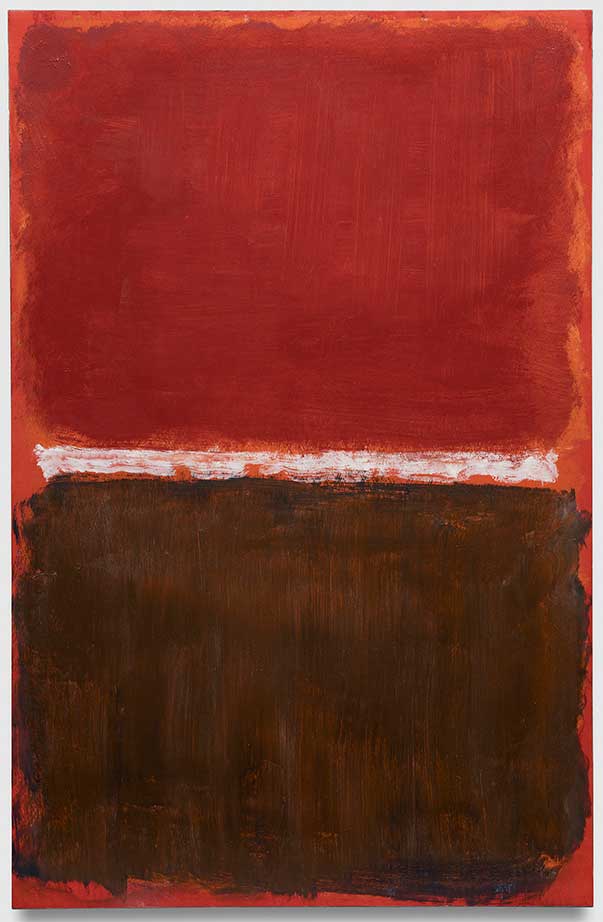
Mark Rothko. Untitled, 1969. Acrylic on paper mounted on panel, 40 × 26-1/2 in (101.6 × 67.3 cm). Artworks on paper by Mark Rothko Copyright © 2020 by Kate Rothko Prizel and Christopher Rothko.
1968: Clearing Away, the inaugural exhibition in Pace’s new Hanover Square gallery, is the first show ever to be devoted to this significant late episode in Rothko’s practice. It comes 60 years after a seminal Whitechapel Gallery exhibition introduced the artist to Britain, and comprises largely not-for-sale works from private collections. As a statement to open a new space, it is a masterstroke. Pace has begun its new London chapter with an essential appointment. It is also a crowd-pleaser: there were throngs of people on both my visits, a rarity for London’s private galleries.
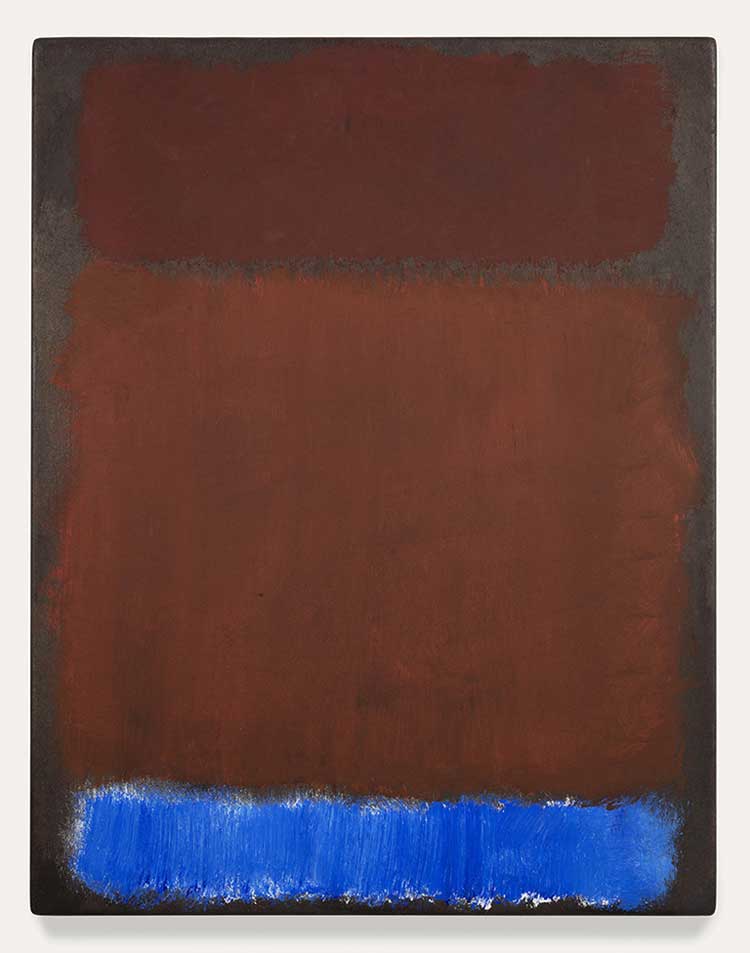
Mark Rothko. Untitled, 1968. Acrylic on paper mounted on board, 23-3/4 × 18-5/8 in (60.3 × 47.3 cm). Private collection, New York, courtesy Alex Brotmann Art Advisory. Artworks on paper by Mark Rothko Copyright © 2020 by Kate Rothko Prizel and Christopher Rothko.
We shouldn’t be surprised. The works of Rothko retain a special hold, more than half a century after his death. All art is activated by being beheld. But Rothko’s abstracts take things to extremes. As he wrote in 1947, two years before his first colour-field work: “A picture lives by companionship, expanding and quickening in the eyes of a sensitive observer. It dies by the same token.” In 2012, one of his paintings at the Tate Modern died almost literally, after a visitor defaced it with black ink. Rothko’s formal simplicity and textural ingenuity have come to serve as mirrors of the emotions of its viewers. They can also appear to be windows into their troubled creator’s soul. “These paintings,” wrote the art critic David Sylvester of the Whitechapel show, “are the complete fulfilment of Van Gogh’s notion of using colour to convey man’s passions.” The comparison is telling.
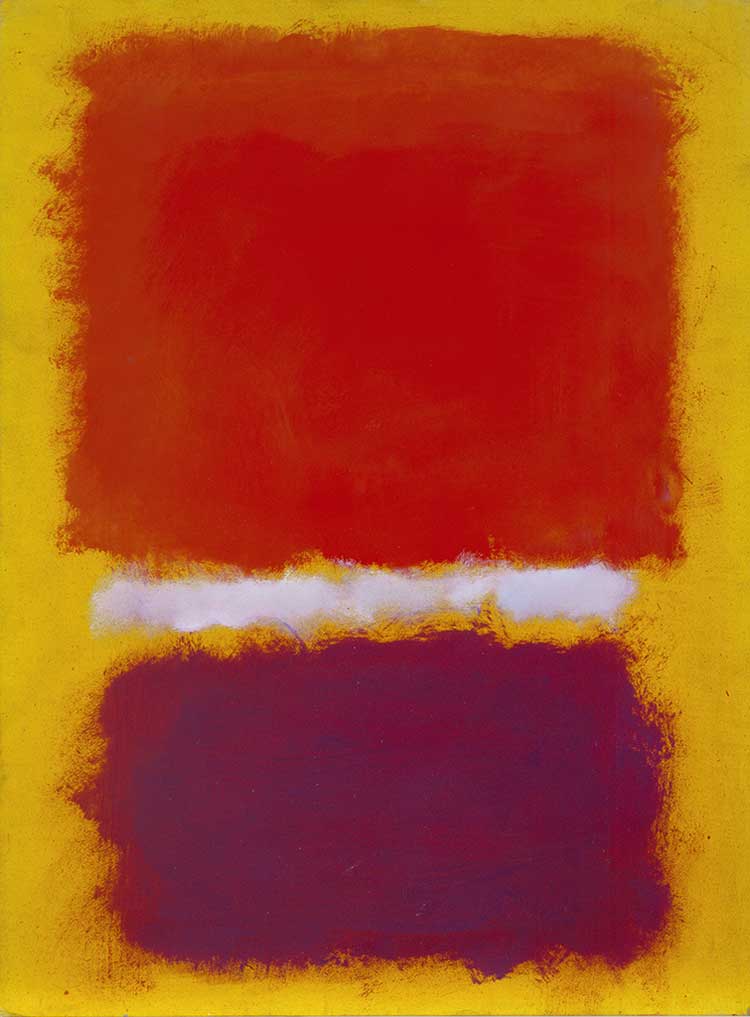
Mark Rothko. Untitled, c1959 or 1968. Tempera on paper drawing board, 30-1/2 × 22-1/2 in (77.5 cm × 57.2 cm). Artworks on paper by Mark Rothko Copyright © 2020 by Kate Rothko Prizel and Christopher Rothko.
Rothko’s concern with feeling was overt. “I’m interested only in expressing basic human emotions – tragedy, ecstasy, doom, and so on,” he wrote on a 1957 exhibition label. More ambitious are the particular passions or states that each work captures. Faced with the artist’s silence on the matter, it is all too tempting to turn to biography. His 1970 series of Black on Grey works, a stark step away from the rich palette of earlier works, are easy to interpret as a coda from an artist who would soon kill himself, the painterly equivalent of the fraught final minutes of Mahler’s Sixth Symphony. But they might equally be inspired by the Apollo moon landings at that time, with their stone greys and black voids. Or maybe Rothko, an artist clued into the formal history of painting and decoration, might simply have wanted to explore grisaille tones. Or perhaps they result from all of the above, or none of them, or something else entirely.
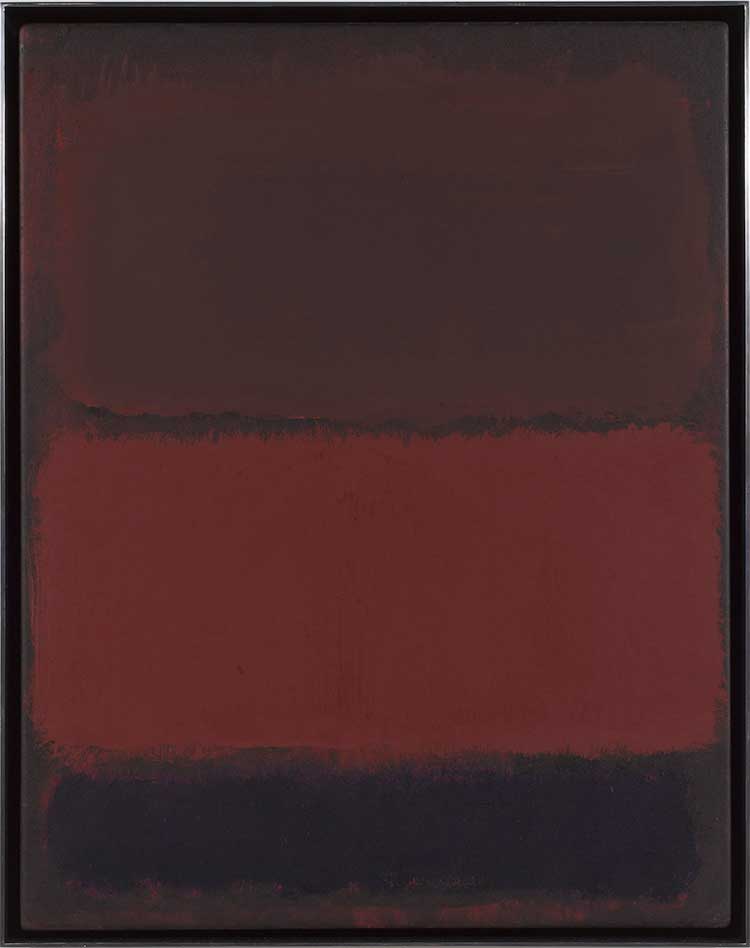
Mark Rothko. Untitled, 1968. Acrylic on paper mounted on panel, 23-15/16 x 18-13/16 in (60.8 cm x 47.8 cm). Collection of Peter Marino. Artworks on paper by Mark Rothko Copyright © 2020 by Kate Rothko Prizel and Christopher Rothko.
The works in Clearing Away present a similar ambiguity: beyond the known facts of his physical deterioration, what do we draw from Rothko’s decision to use paper, to paint in acrylic, to work at smaller sizes? Is there an intimacy here lacking in his other works? And does the smaller scale lead to a diminishment in power? The answer to the last question at least is clear. Rothko’s mastery of colour and texture was undiminished in his infirmity. The immensity of his canvases has often been cited as a primary reason for their absorptivity: pictures so big that you can’t help but be overwhelmed by them. But his smaller works allow for a different kind of active engagement, where you can receive the gem-like whole rather than lose oneself in vast space.
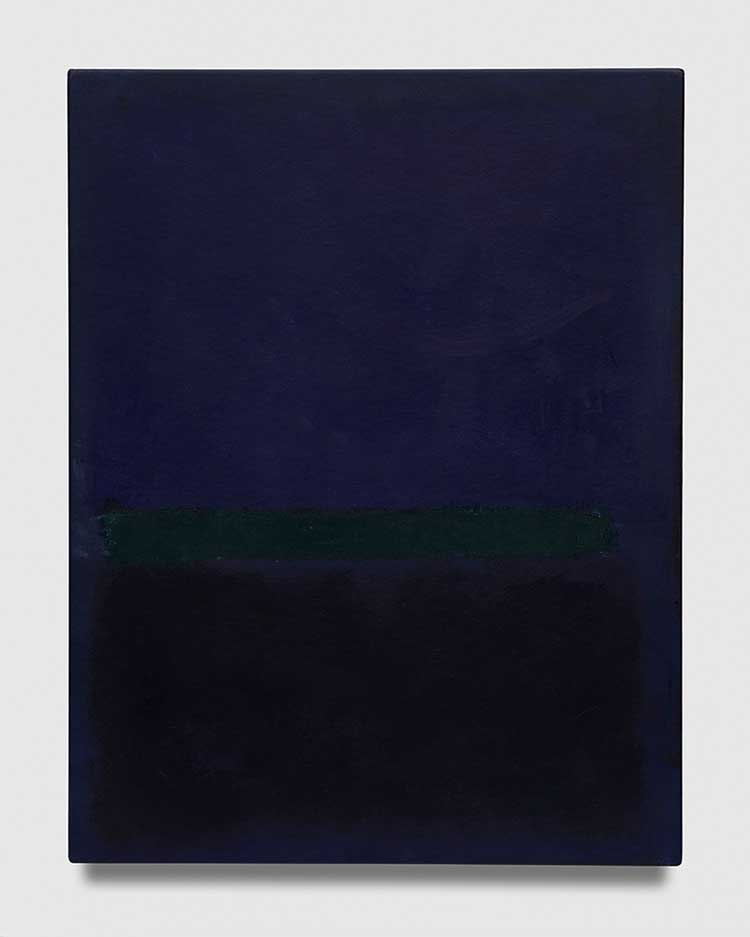
Mark Rothko. Untitled, 1968. Acrylic on paper mounted on panel, 33-1/16 × 25-5/8 × 1-3/8 in (84 × 65.1 × 3.5 cm). Artworks on paper by Mark Rothko Copyright © 2020 by Kate Rothko Prizel and Christopher Rothko.
The works at Pace cover the entire spectrum. Two pieces with black slabs above dusky, earthly backdrops might be a prelude to the Black on Greys to come, while another has walls of black broken only by infernal red. Yet even the darkest works have chinks of light. And the overall tone is anything but maudlin. There are numerous warm hues: oranges and ochres, reds and yellows, and, in one striking case, pink. Some works are better than others, though all have the painter’s characteristic ebbs and flows. It is refreshing to see Rothko working with such spontaneity. Rothko was fixated with process, but paradoxically his larger works are so densely layered that they can be difficult to connect to the mere movements of the mortal hand. The pieces here are the closest you can get to seeing his workings.
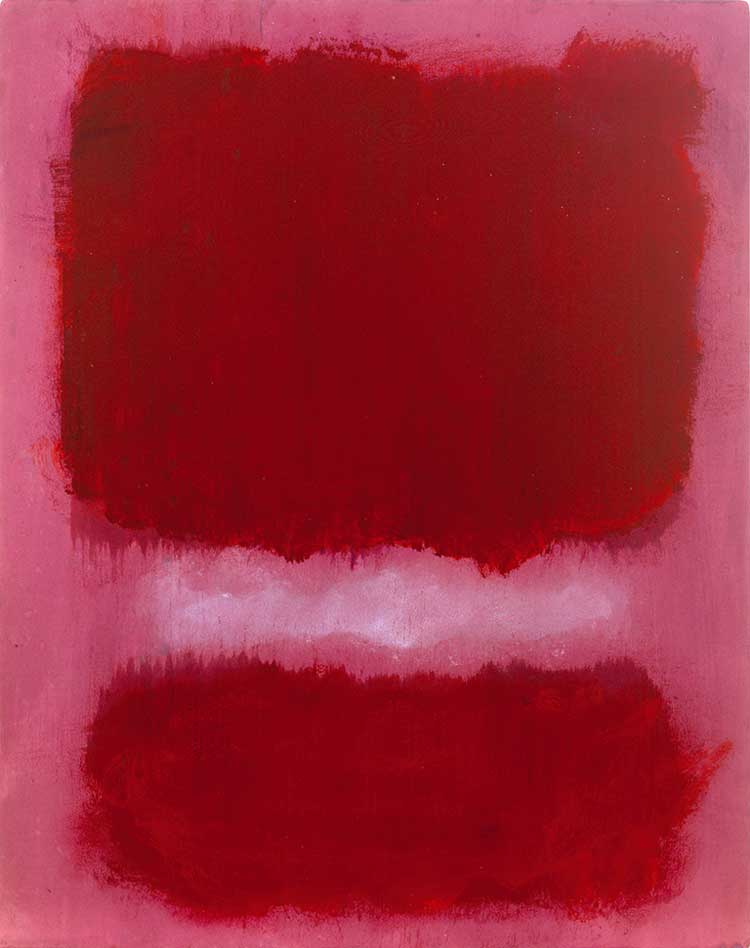
Mark Rothko. Untitled, 1968. Acrylic on paper mounted on panel, 23-7/8 × 18-3/4 × 1-3/8 (60.6 × 47.6 × 3.5 cm). Artworks on paper by Mark Rothko Copyright © 2020 by Kate Rothko Prizel and Christopher Rothko.
They are also distinct in their lightness. He quickly came to master the subtleties of fast-drying, water-soluble acrylic, and some of the best works here have a featheriness that seems very far indeed from the heaviness of his larger works. Rothko saw his works as spiritual: “The people who weep before my pictures,” he said to one critic, “are having the same religious experience I had when I painted them.” Pace has followed the artist’s own preferences in lowering the lighting, giving the galleries a hushed, semi-sacred atmosphere. But the true pleasure of Clearing Away is seeing Rothko stripped of his solemnity, as a painter rather than a priest.
Jonathan Baldock – interview: ‘Weird is a word that’s often used to...
As a Noah’s ark of his non-binary stuffed toys goes on show at Jupiter Artland, Jonathan Baldock t...
Helen Chadwick: Life Pleasures
Helen Chadwick’s unwillingness to accept any binary division of the world allowed her to radically...
Dame Jillian Sackler, the art lover and philanthropist, has died aged 84...
Catharsis: A Grief Drawn Out – book review
To what extent can the visual language of grief be translated? Janet McKenzie looks back over 20 yea...
Radical Software: Women, Art & Computing 1960-1991
With more than 100 works by 50 artists, this show examines the pioneering role of women in computer ...
Giuseppe Penone: Thoughts in the Roots
With numerous works created with the twigs, leaves, roots, branches and majestic forms of trees, thi...
Solange Pessoa: Pilgrim Fields
An olfactory orgy of marigolds, chamomile, grasses, sheepskins and kelp is arranged into a surreal l...
Christian Krohg: The People of the North
A key figure in Norwegian art, naturalist painter Christian Krohg wanted his art to bring social cha...
This comprehensive show charts the groundbreaking rise of the illustrated poster in 19th-century Fra...
Caspar David Friedrich: The Soul of Nature
This comprehensive show celebrating last year’s 250th anniversary of the Romantic painter’s birt...
A humongous survey of contemporary painting in Belgium shows a medium embracing the burden of its hi...
A retrospective of the first 20 years of the Max Mara Art Prize for Women finds an inexhaustible wel...
This new work is very much about indeterminate selfhood as Nora Turato immerses the visitor in a swi...
Burmese artist Htein Lin has been jailed many times and this show includes some of the remarkable pa...
This retrospective brings the acclaimed and trailblazing, but nearly forgotten French modernist arti...
Mainie Jellett and Evie Hone: The Art of Friendship
A kaleidoscope of colour through which the history of modernism is refracted, this exhibition brings...
In this major retrospective, the viewer is like an avatar navigating the humans – real and CGI –...
Sharjah March Meeting 2025: To Carry Songs
Sharjah Art Foundation’s annual symposium this year explored how culture is preserved and shared w...
Christopher Le Brun & Charlotte Verity – interview: ‘There is such a t...
To coincide with a rare joint exhibition now on view at The Gallery at Windsor in Florida, Christoph...
Valentina Karga highlights the ecological horrors ravaging our world, but her aim is not to shock or...
Peter Mitchell: Nothing Lasts Forever
Peter Mitchell’s photographs of urban decay and the demolition of buildings in Leeds over the past...
Lee’s headless heroines and canines are the fifth of the Met’s Genesis Facade Commissions. But w...
Lina Lapelytė – interview: ‘Between this group of performers, what we...
Perhaps best known for her eco-opera Sun & Sea (Marina), Lina Lapelytė discusses her approach to im...
Spanning four centuries and diverse cultures, this show of more than 7o works, including paintings, ...
With highlights from the Courtauld’s collection of German and Austrian modernist works on paper an...
Louise Bourgeois, Sheida Soleimani and Gillian Wearing are among the 30 female artists contributing ...
In this mind-blowing and dazzling exhibition, Rafał Zajko takes us into a mysterious realm of art a...
Mahtab Hussain: What Did You Want to See?
With portraits of mosques and people at prayer, British Asian photographer Mahtab Hussain documents ...
The Cosmos of “Der Blaue Reiter” – From Kandinsky to Campendonk
This show retraces the roots of the expressionist artists who made up the Blue Rider group, looking ...
Celia Paul: Colony of Ghosts* and Celia Paul: Diaries**
Two concurrent solo exhibitions paint a much broader portrait of the artist Celia Paul, debunking th...